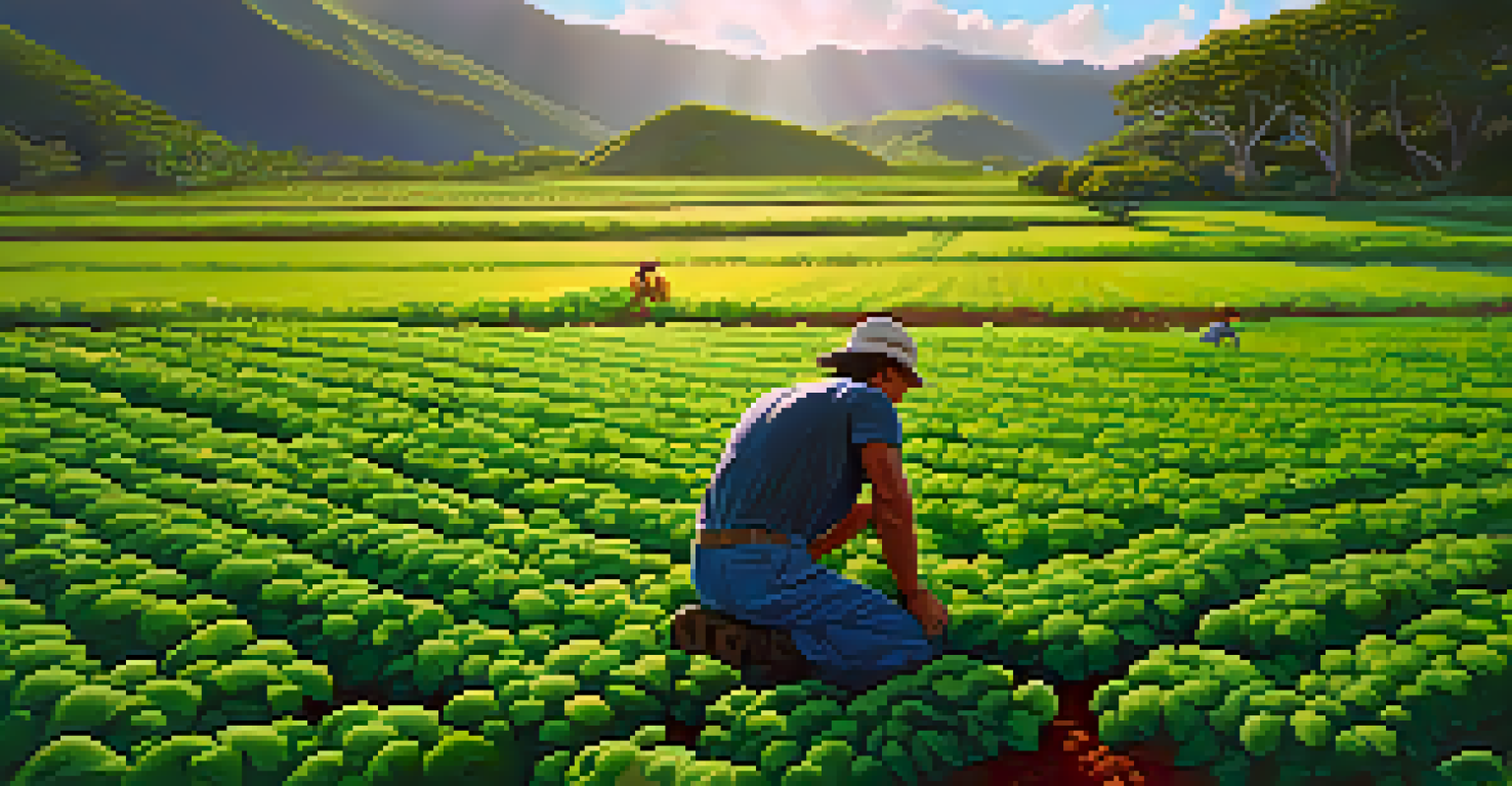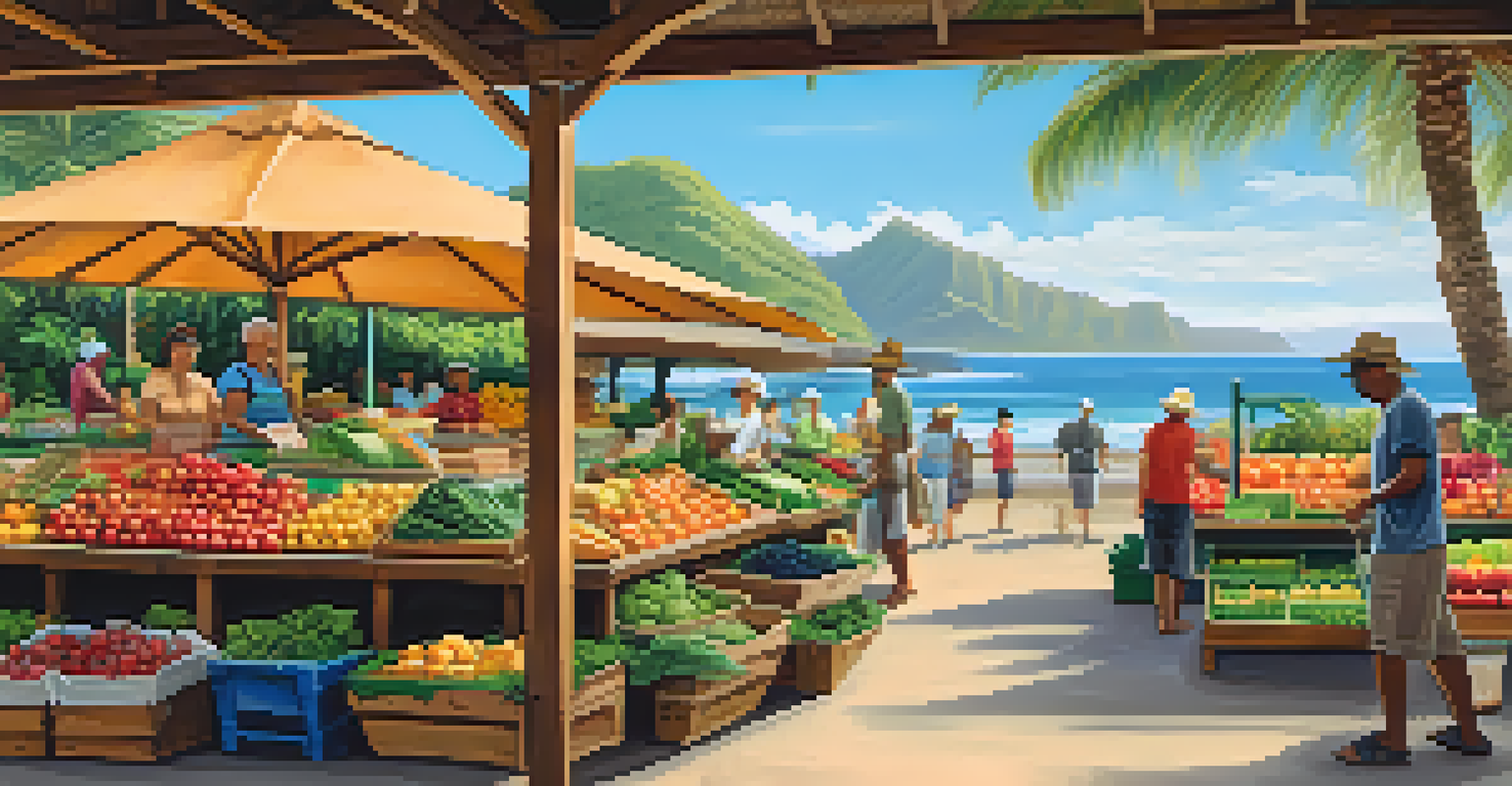Sustainable Agriculture Practices for Hawaii's Unique Climate

Understanding Hawaii's Unique Climate for Agriculture
Hawaii's climate is a fascinating blend of tropical and subtropical conditions, which can pose both challenges and opportunities for agriculture. With its diverse microclimates, each island has different rainfall patterns, temperature ranges, and soil types. This variability means that farmers must adopt practices that are not just effective, but also sustainable and adaptable to their specific environments.
The land is the source of life and sustenance, and we must learn to work with it, not against it.
For instance, the windward sides of the islands receive ample rainfall, while the leeward sides can be quite dry. Recognizing these differences helps farmers choose appropriate crops and irrigation methods, ensuring that they use resources wisely. By understanding the unique aspects of Hawaii's climate, farmers can implement practices that not only support their yields but also protect the environment.
Moreover, the interaction between the climate and the native ecosystems is crucial. Sustainable agriculture in Hawaii involves working in harmony with these ecosystems, preserving biodiversity, and utilizing native plants and traditional farming techniques. This approach not only helps sustain the land but also fosters resilience against climate change.
Embracing Agroforestry: A Sustainable Solution
Agroforestry, the practice of integrating trees and shrubs into agricultural landscapes, is gaining momentum in Hawaii. This method not only enhances biodiversity but also improves soil health and water retention, which are particularly important in a place with such varied rainfall. By planting native trees alongside crops, farmers can create a more balanced ecosystem that benefits both the land and the crops.

Additionally, agroforestry practices can provide farmers with alternative sources of income. For example, farmers can grow coffee or macadamia nuts under the shade of taller trees, which allows for a more sustainable use of land. This multi-layered approach not only boosts productivity but also contributes to the overall resilience of the farming system.
Hawaii's Climate Shapes Farming Practices
Farmers in Hawaii must adapt their agricultural methods to the diverse microclimates and unique rainfall patterns found across the islands.
Moreover, agroforestry can play a pivotal role in sequestering carbon, helping to mitigate climate change. By planting trees that absorb carbon dioxide from the atmosphere, farmers not only contribute to a healthier environment but also improve the long-term sustainability of their agricultural practices.
Utilizing Cover Crops to Enhance Soil Health
Cover crops are an essential tool in sustainable agriculture, especially in Hawaii, where soil health can be compromised by erosion and nutrient depletion. These crops, grown primarily to cover the soil rather than for harvest, help prevent erosion, improve soil structure, and increase organic matter. By planting cover crops, farmers can enhance the fertility of their fields while reducing the need for chemical fertilizers.
Sustainability is about ecology, economy, and equity.
For example, legumes like clover or vetch can fix nitrogen in the soil, providing a natural fertilizer for subsequent crops. This not only cuts down on input costs but also leads to healthier plants and improved yields. In Hawaii’s diverse agricultural landscape, using cover crops can be a game changer, fostering a more resilient and productive farming environment.
Additionally, cover crops can help manage pests and diseases by disrupting their life cycles. By introducing plants that are not hosts for certain pests, farmers can naturally reduce their populations, leading to less reliance on pesticides. This practice not only benefits the farmers but also supports the overall health of the ecosystem.
Water Conservation Techniques for Hawaiian Farms
Water conservation is paramount in Hawaii, where water resources can be limited, particularly in drier areas. Implementing techniques such as drip irrigation and rainwater harvesting can significantly improve water efficiency on farms. These methods ensure that crops receive the necessary hydration without wasting precious resources, making them ideal for Hawaii's unique climate.
For instance, drip irrigation delivers water directly to the plant roots, reducing evaporation and runoff. This targeted approach allows farmers to use less water while still maintaining healthy crops. Furthermore, incorporating rainwater harvesting systems can help capture and store rainwater for future use, providing a sustainable water source during dry spells.
Agroforestry Boosts Sustainability
Integrating trees and shrubs into farming not only enhances biodiversity but also improves soil health and provides farmers with alternative income sources.
Additionally, mulching can play a crucial role in conserving soil moisture. By covering the soil with organic materials, farmers can reduce evaporation and suppress weeds, creating an environment that retains water more effectively. This simple yet effective practice can lead to healthier crops and a more sustainable farming operation.
Integrating Organic Farming Practices in Hawaii
Organic farming is a growing trend in Hawaii, offering a way to produce food sustainably while preserving the islands' unique ecosystems. By avoiding synthetic fertilizers and pesticides, organic farmers promote biodiversity and soil health, which are vital for long-term agricultural success. This approach not only benefits the environment but also meets the increasing consumer demand for organic produce.
For example, using compost and natural amendments helps enrich the soil without the harmful effects of chemicals. This not only leads to healthier crops but also supports a vibrant micro-ecosystem within the soil. Furthermore, organic practices promote the use of crop rotation and companion planting, which can enhance pest control and improve yields.
Moreover, organic farming in Hawaii can serve as a model for sustainable practices worldwide. By showcasing the benefits of organic methods, Hawaiian farmers can inspire others to adopt similar approaches, contributing to a global movement toward more sustainable agriculture. This interconnectedness highlights the importance of local practices in the broader context of environmental stewardship.
Community Supported Agriculture: Building Stronger Connections
Community Supported Agriculture (CSA) is an innovative model that connects local farmers directly with consumers, fostering a sense of community and sustainability. In Hawaii, CSAs allow farmers to sell their produce directly to consumers, providing fresh, seasonal products while reducing the carbon footprint associated with transportation. This model not only supports local economies but also encourages sustainable farming practices.
By participating in a CSA, consumers become invested in the farming process, often receiving regular updates about the farm and its practices. This transparency builds trust and encourages a deeper relationship between consumers and producers, promoting a shared commitment to sustainability. It’s a win-win situation: farmers gain financial stability while consumers enjoy fresh, locally grown food.
Traditional Techniques Enhance Resilience
Reviving traditional Hawaiian farming methods can improve productivity while honoring cultural heritage and promoting environmental sustainability.
Moreover, CSAs can mitigate food insecurity by ensuring that fresh produce is accessible to communities. By prioritizing local food systems, Hawaiian farms can contribute to a more resilient food network, reducing dependence on imported goods and enhancing community well-being. This model exemplifies how sustainable agriculture can strengthen both the environment and local communities.
Traditional Hawaiian Farming Techniques: A Path to Sustainability
Hawaii’s agricultural heritage is rich with traditional farming techniques that have sustained its communities for centuries. Practices such as the 'ahupua'a system, which integrates land and sea resources, illustrate a holistic approach to resource management. By learning from these time-tested methods, modern farmers can adopt sustainable practices that are in harmony with the island's ecosystems.
For example, the use of taro farming in lo'i (wetland fields) demonstrates how water management can be effectively integrated into agriculture. This method not only supports the cultivation of taro but also preserves native aquatic ecosystems. By reviving such practices, farmers can enhance their productivity while respecting the land's cultural significance.

Furthermore, incorporating traditional knowledge into contemporary farming can foster resilience against climate change. By blending modern techniques with ancestral wisdom, Hawaiian farmers can create a more sustainable agricultural system that honors their roots and prepares for the future. This approach not only preserves cultural heritage but also promotes environmental stewardship.